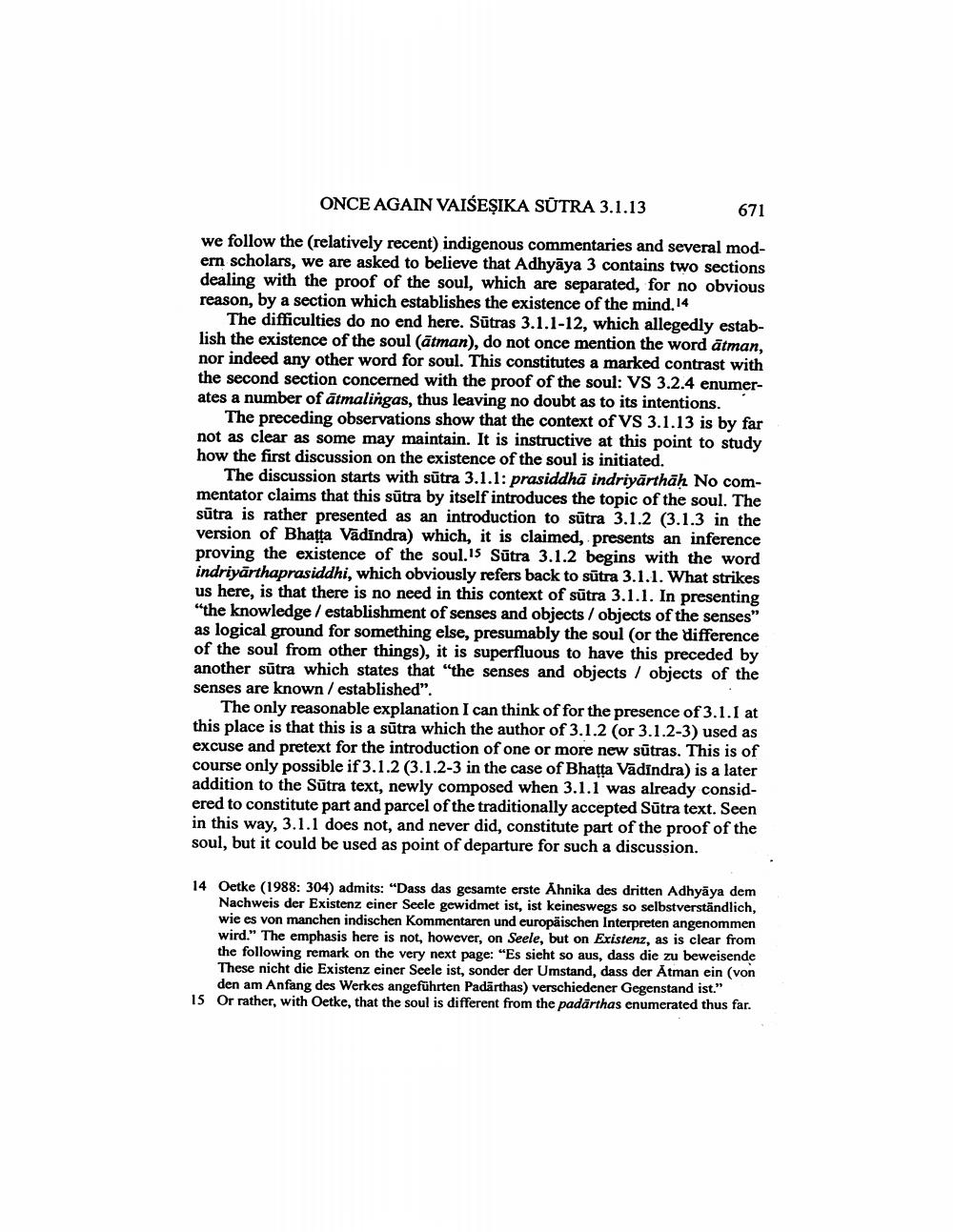Book Title: Once Again Vaisesika Sutra 3 1 13 Author(s): Johannes Bronkhorst Publisher: Johannes Bronkhorst View full book textPage 7
________________ ONCE AGAIN VAIŠEŞIKA SŪTRA 3.1.13 671 we follow the (relatively recent) indigenous commentaries and several modern scholars, we are asked to believe that Adhyāya 3 contains two sections dealing with the proof of the soul, which are separated, for no obvious reason, by a section which establishes the existence of the mind. 14 The difficulties do no end here. Sūtras 3.1.1-12, which allegedly establish the existence of the soul (ātman), do not once mention the word ātman, nor indeed any other word for soul. This constitutes a marked contrast with the second section concerned with the proof of the soul: VS 3.2.4 enumerates a number of ātmalingas, thus leaving no doubt as to its intentions. The preceding observations show that the context of VS 3.1.13 is by far not as clear as some may maintain. It is instructive at this point to study how the first discussion on the existence of the soul is initiated. The discussion starts with sūtra 3.1.1: prasiddhā indriyārthāh No commentator claims that this sūtra by itself introduces the topic of the soul. The sūtra is rather presented as an introduction to sūtra 3.1.2 (3.1.3 in the version of Bhatta Vädindra) which, it is claimed, presents an inference proving the existence of the soul. 15 Sūtra 3.1.2 begins with the word indriyārthaprasiddhi, which obviously refers back to sūtra 3.1.1. What strikes us here, is that there is no need in this context of sūtra 3.1.1. In presenting "the knowledge / establishment of senses and objects / objects of the senses." as logical ground for something else, presumably the soul (or the difference of the soul from other things), it is superfluous to have this preceded by another sūtra which states that "the senses and objects l objects of the senses are known / established". The only reasonable explanation I can think of for the presence of 3.1.1 at this place is that this is a sūtra which the author of 3.1.2 (or 3.1.2-3) used as excuse and pretext for the introduction of one or more new sūtras. This is of course only possible if 3.1.2 (3.1.2-3 in the case of Bhatta Vādindra) is a later addition to the Sūtra text, newly composed when 3.1.1 was already considered to constitute part and parcel of the traditionally accepted Sūtra text. Seen in this way, 3.1.1 does not, and never did, constitute part of the proof of the soul, but it could be used as point of departure for such a discussion. 14 Oetke (1988: 304) admits: "Dass das gesamte erste Ahnika des dritten Adhyāya dem Nachweis der Existenz einer Seele gewidmet ist, ist keineswegs so selbstverständlich, wie es von manchen indischen Kommentaren und europäischen Interpreten angenommen wird." The emphasis here is not, however, on Seele, but on Existenz, as is clear from the following remark on the very next page: "Es sieht so aus, dass die zu beweisende These nicht die Existenz einer Seele ist, sonder der Umstand, dass der Atman ein (von den am Anfang des Werkes angeführten Padārthas) verschiedener Gegenstand ist." Or rather, with Oetke, that the soul is different from the padārthas enumerated thus far.Page Navigation
1 ... 5 6 7 8 9 10 11 12 13 14 15 16 17
